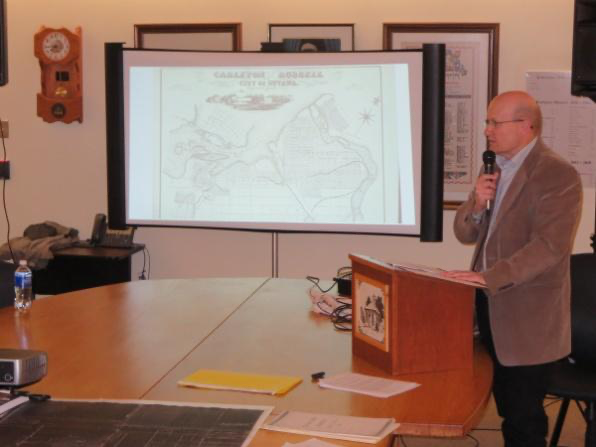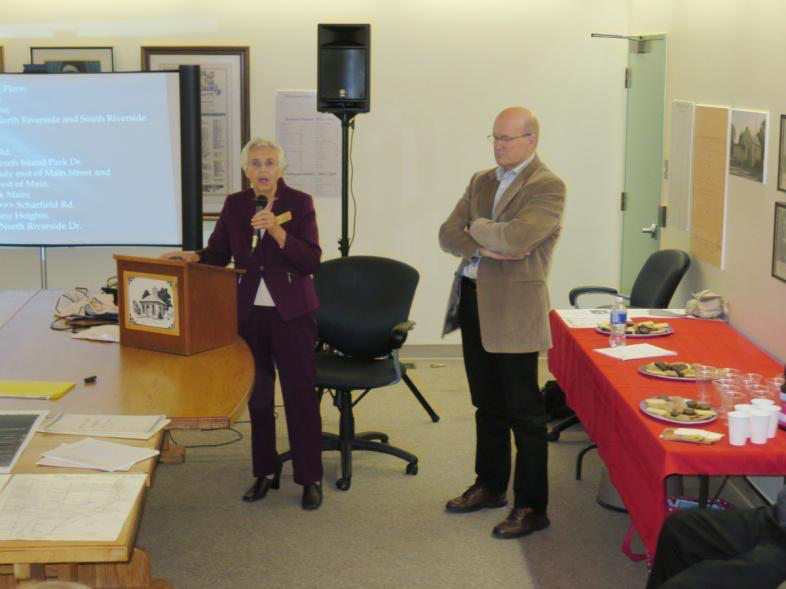Street Names in Old and New Ottawa
Street Names in Old and New Ottawa
Speakers: Serge Barbe and Georgie Tupper. Article by Jane Anderson. Photos by Owen Cooke. November, 2016.
The subject was the origin of street and road names in Rideau Township and Ottawa. Both speakers are eminently qualified to speak on the subject. Serge, a retired City of Ottawa Archivist, is a History Graduate from Ottawa U. His career was spent in Ottawa, and he was Community Archivist, working at the Rideau Branch once a week. Street names have always been a special interest of his.
Georgie Tupper is a long time Rideau resident. She was a founding member of the RTHS, and has been a mainstay of the North Gower Branch of the City of Ottawa Archives since its inception. She was a member of the original Naming Committee for roads in Rideau, and also served on the Duplication Committee at the time of amalgamation with Ottawa.
Old Ottawa
Serge began with an overview of Ottawa street names. Many bear the name of pioneer Ottawans. Colonel By Parkway was inaugurated after the closing of the downtown Union Station. The parkway was created by using the old rail lines that led to the station and which also crossed the Colonel By estate. The beautiful 2 parkway which winds along the east shore of the Rideau Canal is a fitting tribute to the man behind it. The following is a list of Ottawa street names, and the persons whose memory they honour.
Rideau Street area
Dalhousie Street – after Lord Dalhousie, the Governor General who gave his approval to the construction of the Rideau Canal.
Bolton and Bottler Street – both engineers who worked on the Canal.
Nelson Street – honours Lord Nelson, winner of the Battle of Trafalgar.
Lower Town
Bruyere Street recognizes the contribution of Mother Bruyere, founder of the Grey Nuns, who went on to found the first hospital in Ottawa which became the Ottawa General. She also established an orphanage, and founded a bilingual school which became the Sacred Heart Convent. Guigues Street pays tribute to Bishop Guigues, who was a colleague of Mother Bruyere, and founded the College of Bytown which became Ottawa U. He also established the separate school system in Ontario.
Other civic leaders who were recognized for their leadership live on in street names in the heart of Ottawa: Heney, a volunteer firefighter, and Desjardins, councillor, photographer and public servant. Friel Street - Henry Friel, councillor and mayor of Bytown and Ottawa, and co-owner of the Bytown Packet, Bytown’s first newspaper and precursor to the Ottawa Citizen.
Bell Street - Robert Bell, MLA and co-owner of the Bytown Packet.
Nicholas Sparks was an Irish immigrant who came to work for the Wright family. Once settled, he purchased a large tract of land now covering a major part of downtown Ottawa. He became wealthy selling off tracts of land; he made generous donations to various churches and institutions such as the Court House off Nicholas Street. He cemented his social status by marrying the widow of Philemon Wright. He also served on the municipal council. Today, Sparks Street which partially bisects his holdings does him honour. O’Connor Street - Daniel O’Connor - JP, Judge, Shop Keeper
Slater Street - James Dyson Slater - Engineer, Superintendent of the Rideau Canal, married Esther Sparks.
MacLaren Street- James MacLaren - Lumberman , established the Bank of Ottawa which merged with the Bank of Nova Scotia.
Blackburn Avenue - Robert Blackburn - Merchant, Mill Owner, Reeve of New Edinburgh
Sandy Hill
Louis Theodore Besserer purchased a tract of land known as the Besserer Estate, now known as Sandy Hill. Besserer Street - Louis Theodore Besserer, subdivider of Sandy Hill Stewart Street - William Stewart, agent of LT Besserer.
Lebreton Flats
Captain John Lebreton - hero of the War of 1812. Purchased the land. Booth Street - JR Booth 1827-1925, successful industrialist, lumber and railroad baron, philanthropist, having generously contributed to St. Luke’s and County Carleton General Hospitals which were forerunners of the Civic Hospital.
Serge concluded by noting that the responsibility for street names generally falls upon owners and 3 developers.
Rideau
Georgie Tupper then took the floor to tell us about Rideau Township Roads.
When North Gower and Marlborough Townships were originally surveyed, fourteen per cent of the land was reserved for the Crown and the Clergy. The remainder was available as grants to Loyalists, and sales to settlers. Theodore de Pencier surveyed Marlborough, making use of the surveyor’s chain and John Stegman surveyed North Gower. During the survey, curves in the Rideau River had to be accounted for, hence the curves in the road. Fourteen per cent of the Townships were reserved for the Crown and the Clergy. The remainder was available as grants to Loyalists, and sales to settlers. A road was to be opened in front of the lot as a condition of the land grant.
There were no established roads for the early settlers; instead they had to rely on the rivers and streams, and Indian trails. From Lindsay’s Wharf in Kars, the pioneers who settled North Gower travelled along Lockhead Road, or across Thompson’s swamp by corduroy road. For the early township councils, road building and maintenance was the first order of business. Pathfinders organized the landowners to build and maintain sections of the roads. Sowing and harvest times were taken into account; the farmers were given the opportunity to work on the land. The early wooden bridges required particularly high maintenance ; the iron wheels and horses’ hooves were destructive.
In 1973, Basil Parsons and Elijah Scharf of the North Gower Council asked Coral Lindsay and Georgie Tupper to form a road naming committee. The policy was to name the roads after early settlers. However, this was not accepted by Council.
In 1974, Rideau Township was formed, consisting of Marlborough and North Gower Townships and all of Long Island in Manotick. The Road Naming Committee was reactivated. “Jogs” were corrected. It was decided to keep the Concession and Line numbers . There was to be no duplication of street names in North Gower, Kars, Manotick, Carleton Golf and Yacht Club and Boucher Subdivision.
Roger Stevens Drive, the longest road in Rideau honours Roger Stevens, one of the pioneer settlers in Marlborough. He died prematurely of drowning in Rogers Stevens Creek.
In the case of a dispute amongst neighbours , over the line, it had to be resurveyed ; this is known as a “proven line”. 1977 saw the road names given official status; the green numbers for rural addresses were also distributed, making finding addresses much easier.
The Provincal Highway which goes through Rideau is known variously as Highway 16, the Prescott Highway, and particularly in Ottawa as Prince of Wales. The arrival of Highway 416 cut off existing roads; to compensate the roads were labelled east or west.
With the amalgamation of Rideau Township into the city of Ottawa in 2001, the issue of road names arose again. There was to be no duplications of road names within Ottawa. A decision had to be made as to which name was to be retained, and which was to be changed. Criteria for naming included the number of houses and businesses affected, and the historical significance. Resident participation was invited. Duplicate names were sometimes relived by adding an adjective for example Manotick Main Street. In Kars, Wellington Street became Old Wellington Street (the City often accepted a description), Rideau Street became Rideau Street North and South, and Nelson became Lord Nelson.
In North Gower, Church Street, which was so named in 1852, retained the name over all the Church Streets in Ottawa. Craig Street was also retained. In Manotick, among the changes was Currier for Catherine, Clapp Lane for Church, Indian Road for Hartwell, and John Street for O’Grady east of Manotick Main, and Beaverbrook to the west. Bay Street became Herwig Place, and Henry, Firefly Lane. Colony Heights became Old Colony road. Dickinson Street remains in Ottawa, as it was named at the suggestion of Mayor Whitton..
In the question and answer session after her talk, when asked why road names change, e.g., Mitch Owens to Bridge Street to Bankfield to Brophy, Georgie replied that it is in response to requests by established families.
Georgie & Serge were thanked by the chair, Tom MacDonald, for a most informative talk.


